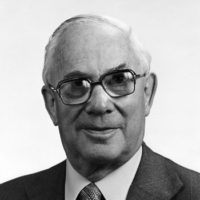
Hans W. Kosterlitz
University of Aberdeen

John Hughes
Imperial College of Science and Technology

Solomon H. Snyder
Johns Hopkins University School of Medicine
For identifying the relation of the opiate receptors to the naturally occurring enkephalins.
Hans Kosterlitz
In recent years, scientists proved a long-standing theory that the brain is able to process information relating to pain, and that there are normally opiate-like substances in the brain which have been named enkephalins, which are neurotransmitters of messages relating to pain and emotional behavior.
Dr. Kosterlitz realized that in view of the complexity of the central nervous system, simpler models in the peripheral nervous system would be necessary in order to investigate the mode of opiate action. He showed that the opiate receptors in the nervous tissue of several visceral effects of these drugs were specifically prevented by the opiate antagonistic naloxone. These observations were essential for the successful use of these models for the assessment of the action of narcotic analgesics and later of the enkephalins.
He also realized that the opiate receptor system was similar in character to other neurotransmission systems. He proposed the view that the real function of these receptors was not their interaction with the alien alkaloids of the opium poppy but with compounds with similar action occurring in the nervous system of animals and man. This concept triggered the search for the enkephalins and made possible the efficient monitoring of the progress in the isolation and purification of the enkephalins.
To Dr. Kosterlitz, for his early and pioneering contributions which have major implications for understanding the natural factors that influence pain, narcotic addiction, and the emotions, this 1978 Albert Lasker Basic Medical Research Award is given.
Solomon Snyder
The similarity of the chemical structure of many opiate drugs had early suggested to research workers the possibility that membranes of brain and other body tissues possessed specific chemical configurations that selectively bound these drugs and accounted for their action.
Dr. Snyder not only identified this receptor system, but with his co-workers, went on to develop precise techniques for localizing these opiate receptors, and then mapped their regional distribution in the brain.
Subsequently, his laboratory demonstrated, in a systematic fashion, the role of sodium in the differentiation of opiate agonists from antagonists. The same finding led to important theoretical explanations of how opiate agonists differ from antagonists.
To Dr. Snyder, whose delineation of the mechanisms of action of the opiate drugs lies at the relief of pain and the counteracting of narcotic addiction, this 1978 Albert Lasker Basic Medical Research Award is given.
For demonstrating the specific structure of the enkephalins and the identification of their natural origin.
John Hughes
Dr. Hughes early reasoned that morphine receptors do not exist by chance or in isolation, but in fact form a part of a neurotransmitter system that functions through the mediation of a morphine-like compound naturally occurring in the body. He approached the hypothesis directly, taking brain extracts and testing their effects on smooth muscle. The experiments led to the preparation of extracts of brain which had a biological action equivalent to that occurring when maximum amounts of morphine are administered.
Further chemical purification of the brain extracts led to the isolation and characterization of two polypeptides now termed enkephalins. The similarity of the amino acid sequence in one of the enkephalins to a part of beta-lipotropin has raised questions as to a possible precursor role of this substance in enkephalin formation.
Dr. Hughes's discovery has stimulated extensive work searching for sources of the enkephalins and of other naturally occurring chemicals that possess opiate-like action. Furthermore, it provides an important step in efforts to develop new non-addicting analgesics for the relief of pain in man.
To Dr. Hughes for predicting the existence of, and characterizing the chemical structure of the naturally occurring enkephalins, this 1978 Albert Lasker Basic Medical Research Award is given.
Solomon H. Snyder
Acceptance remarks, 1978 Lasker Awards Ceremony
I am honored that the Lasker Foundation has chosen this year to recognize the field of opiate receptor and opiate-like peptide research. Among the many people who contributed to this area, my own special thanks go to Candace Pert who, as a graduate student, identified the opiate receptors in my laboratory.
Opiate receptor research has paid off both in fundamental understanding of brain function and in the development of novel therapeutic agents. The techniques for measuring opiate receptors have now been applied to receptors for most known neurotransmitters, the substances which carry information between neurons in the brain.
Screening test drugs for influences on the opiate receptor and on receptors for other neurotransmitters has permitted a more scientific, logical, systematic and cheaper way of identifying new, more effective and sometimes safer drugs.
The remarkable identification of the enkephalins as the naturally occurring neurotransmitters for the opiate receptor by my friends John Hughes and Hans Kosterlitz has greatly enhanced our appreciation of how the brain perceives pain and regulates emotion.
Our work on the opiate receptor was made possible by a deliberate decision in 1972 on the part of the National Institute of Mental Health and the White House Special Action office on Drug Abuse Prevention to allocate some defined portion of the "war on drug abuse" to basic research. Opiate receptor research highlights a phenomenon which this audience knows well. Non-targeted basic medical research can and does provide cost-effective benefits, sometimes very directly, for medical, social and basic scientific application.
Thank you.
